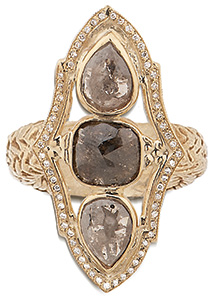|
Cover
Cosmopolitan Confluence
Elaine Selo and Cynthia Shevel travel the world to find jewelry and crafts for their self-named gallery in Ann Arbor, Michigan.
By Joyce Kauf

| Just Jules
|
There has to be a confluence between the customers you attract and the merchandise you carry,” says Elaine Selo, explaining the retailing philosophy that she puts into practice at the Selo/Shevel Gallery in Ann Arbor, Michigan. Along with co-owner Cynthia Shevel, Selo searches the globe for a creative mix of handmade arts that includes fine jewelry, glass, ceramics, wood and Judaica. Together they have turned their gallery into a 30-year success story.
Located on Main Street in Ann Arbor, the gallery was an outgrowth of an earlier venture of these two former academics who met as students at the University of Michigan. Selo was working toward a PhD in social work and sociology, while Shevel was in the master’s program in that same discipline. Shevel dropped out to open Middle Earth, an on-campus crafts store catering primarily to students. After earning her PhD, Selo joined her. “In the beginning, it was an alternative to an academic career. But it became a natural fit for me,” Selo explains.
During buying trips to Asia, Africa and Central America, Shevel and Selo were drawn to merchandise not geared to students’ tastes or budgets. “We wanted a place to showcase products that were more cosmopolitan and that sold at higher price points,” says Selo. Attracted by Ann Arbor’s potential as a shopping destination, they opened their current gallery in October 1982. Their choice proved to be forward-looking; the area is now home to boutiques, restaurants and jazz clubs. While the majority of customers come from Detroit suburbs and neighboring states, the city has seen an influx of tourists, contributing to the gallery’s very diverse customer base.
“The merchandise has to hit me emotionally and aesthetically,” says Selo about her selection criteria. When buying jewelry, Selo tends to reject the trendy in favor of classic designs that “will be treasured by the people who buy it now as well as the generation after them.” Over the years, Selo has increasingly added designers to the jewelry product mix. While acknowledging that brand names are a strong selling point, she seeks out designers who show “originality both in design and in the use of their materials.” Just Jules, Alex Sepkus and Adel Chefridi are among the designers sold at the gallery.
Strong advocates of visual merchandising, Selo and Shevel employ a full-time display person. The gallery is housed in a fairly large, rectangular space with windows along the street. “Jewelry is displayed in the windows in niche cases that were deliberately made very small so that people would have to peer into the window to see them,” notes Selo. Displays are changed frequently. “You have to make it interesting for customers and staff too.”
Ceramics, wood and lower-price-point jewelry are featured in the gallery’s larger room. The more intimate second room is better suited to presenting high-end glass and high-end jewelry. LED lighting is used throughout the gallery. Videos ranging from product shots to jewelry designer Todd Reed at work enhance the shopping ambience.
All the jewelry is displayed under glass. Built-in cases are recessed into the wall. An important aspect of their merchandising is to show a “fair amount of the designer’s work so customers get a sense of it,” according to Selo, who applies this display technique to both higher and lower price points. A separate case is devoted to each jewelry designer, with cards placed inside to indicate the price range and information about that designer. “Letting the customer know this is a piece she can afford creates a comfortable shopping experience,” Selo points out.
“People start with the less expensive and grow with it. We give them an opportunity to start with a small purchase.” Bridal is the exception to individual merchandising because it “makes sense to show all the product lines together,” says Selo.
Selo cites the opportunities of merchandising a range of items. She suggests to customers cross-promoting products that work well together, such as jewelry and scarves.
In 2005, a local man approached them about building a fairy door and window. “We jumped at this opportunity to distinguish our décor,” said Selo. These miniature replicas are carved into the building exterior and people leave treats or little cards in front of them. But they are not only for children — film crews from Scotland and Germany have filmed them for a documentary.
While the fairy door and window may be unique, Selo says there are more substantial reasons that set them apart from the area’s other jewelry stores and galleries. “One way we differentiate ourselves is that we have crafts from other countries and people seem to like that assortment,” she says, adding, “We make a conscious effort not to duplicate products in the other galleries.” Along with offering more fine jewelry than others in the area, the gallery carries a “huge inventory” in general. Selo also credits their website with introducing people to their merchandise.
As an academic turned gallery owner, Selo admits that occasionally she gets to apply her educational background. “I learned from social work that you go to where the client is,” she concludes.Article from the Rapaport Magazine - October 2013. To subscribe click here.
|
|